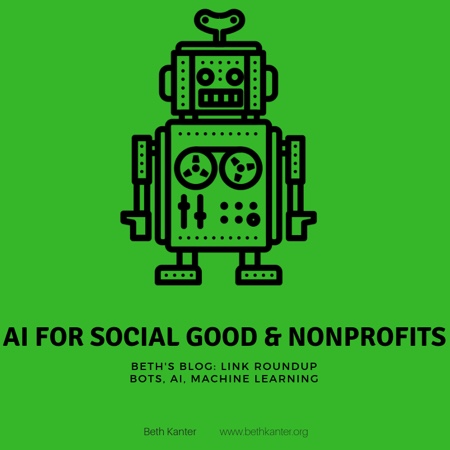
Allison Fine, my co-author for the Networked Nonprofit, and I are actively researching the use of AI for Good, in particular to scale giving and spread generosity. It was almost ten years ago that we published the Networked Nonprofit during the early days of social media and networks. Now, we entering a new digital era which includes emerging technologies like AI.
Artificial Intelligence presents a lot of benefits for the social good sector. But as my colleague, Steven MacLaughlin points out, “We should keep in mind that AI is a “how” and not a “why” or “what” — but that gets lost in a lot of the hype.” He is reminding of us of shiny object syndrome and to be skeptical of technology in search of solutions.
Lucy Bernholz in a post about Nonprofits and Artificial Intelligence also points out that we should not focus on the how nonprofits are using the tools, but there are also some very important ethical concerns. “The REAL issue is how large data sets (with all the legitimate questions raised about bias, consent and purpose) are being interrogated by proprietary algorithms (non-explainable, opaque, discriminatory) to feed decision making in the public and private sectors in ways that FUNDAMENTALLY shift how the people and communities served by nonprofits/philanthropy are being treated.”
Here’s some recent links that look at the why and what. And, I’ve also included a few on the how.
- What Is AI for Good? This is a good analysis of the evolution of Tech for Good, Cloud for Good, Data for Good, and the latest iteration: AI For Good. The author, Eirini Maliaraki,an interaction designer, argues for more precise definition of the emerging field “AI for Good,” with a focus on outcomes, not the technology. The article includes list of proposed best practices for use of AI in development and other social good fields.
- Artificial Intelligence: Snake Oil or Powerful Nonprofit Tool? Allyson Kapin shares a blog post that showcases four different ways that nonprofits are using AI tools.
These include: 1) Field Work – Rainforest Connection is using machine learning to detect illegal logging in vulnerable forests. (Note for more examples of AI used in nonprofit field program work in a variety of applications, check out: Cohort 3 “All Things AI” newsletter and podcast. 2) Fundraising: Charity: Water is using Persado, an AI tool to better understand which content and images on Facebook would generate more recurring donors for its monthly program. (I shared a few more examples of AI-driven fundraising here) 3) Campaign Content: Examples of nonprofits using Quilt.AI, which takes every organization’s digital imprint and lets a nonprofit to better understand data patterns in large amount of data to predict changes in human behavior. These insights are used to better customize messaging in different digital channels to improve results. 4) Story Mapping Personal Stories: Nonprofits have the potential to use AI to analyze personal stories of key stakeholders to better design pathways to using those programs.
- Find The Human-Technology Balance To Champion Your Customers This article is written primarily for small business owners, but it speaks to a point that nonprofits should also consider. How do build good relationships with your stakeholders (customers) using these tools? The article discusses the power of “human technology” — taking advantage of the latest technological advances, while still prioritizing the unique things that only human interactions can deliver.
- What the AI Products of Tomorrow Might Look Like This a wonderful piece from IDEO, a design thinking and innovation firm, that imagines how to best amplify uniquely human characteristics with AI or what they call “Hyper Human.” So many of these ideas could be applied to AI-enhanced fundraising strategies or tools.
How is your organization looking at the impact of new and emerging technologies on the people your serve, your programs, and fundraising?

Leave a Reply